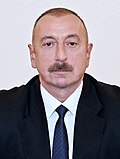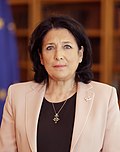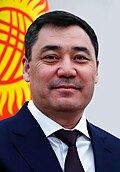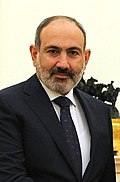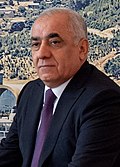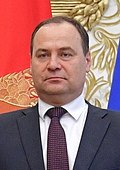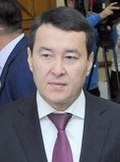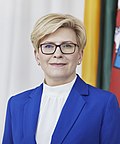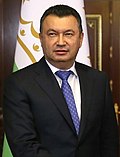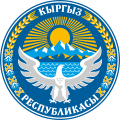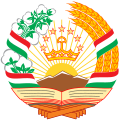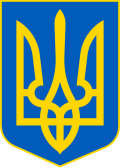Post-Soviet states

The post-Soviet states are the 15 sovereign states that were union republics of the Soviet Union. They emerged from the Soviet Union after thedissolution in 1991.
They are also known as the former Soviet Union (FSU), the former Soviet Republics and in Russia as the near abroad.[1]
Russia is the main de facto internationally recognized successor state to the Soviet Union after the Cold War. Ukraine has, by law, claimed that it is a state-successor of both the Ukrainian SSR and the Soviet Union which stayed under dispute over formerly Soviet-owned areas.<refOn Legal Succession of Ukraine, Articles 7 and 8.</ref>[2][3]
The three Baltic states – Estonia, Latvia, and Lithuania – were the first to declare their independence from the USSR, between March and May 1990. They claimed continuity from the original states which existed before the annexation by the Soviet Union in 1940.[4][5] The remaining 12 republics all left after. All 12 of these republics joined the Commonwealth of Independent States (CIS) and most of the 12 joining the Collective Security Treaty Organization (CSTO). However, the Baltic states focused on European Union (EU) and NATO membership.[6] EU officials have made clear the importance of Association Agreements between the EU and post-Soviet states.[7][8]
Many disputed states with varying degrees of recognition exist within the territory of the former Soviet Union. These are Transnistria in eastern Moldova, Abkhazia and South Ossetia in northern Georgia and Artsakh in southwestern Azerbaijan. Since 2014, the Donetsk People's Republic and Luhansk People's Republic in far eastern Ukraine have claimed independence. All of these unrecognized states except Artsakh depend on Russian armed support and financial aid. Artsakh is part of Armenia at a de facto level, which also maintains close cooperation with Russia. Before its annexation by Russia in March 2014, which was not recognized by most countries, Crimea shortly declared itself an independent state.[9]
Country comparison
The 15 states may be divided into four subregions. Not included in these categories are the several de facto independent states presently lacking international recognition (read below: Separatist conflicts).
| Subregion | Country | Symbols | Capital | Form of government |
Independence | Area[10] | Population | Ethnic majority, percent | Density | Notes | |||||
|---|---|---|---|---|---|---|---|---|---|---|---|---|---|---|---|
| Coat of arms | Flag | km2 | mi2 | 1989 | now | p/km2 | p/mi2 | ||||||||
| Central Asia | Kazakhstan (Republic of Kazakhstan) |

|
Astana | Unitary dominant-party presidential republic |
December 16, 1991 | 2,724,900 | 1,052,090 | 19,000,336 | 39.7% | 7 | 18 | [11][12] | |||
| Kyrgyzstan (Kyrgyz Republic) |

|
Bishkek | Unitary presidential republic |
August 31, 1991 | 199,945 | 77,199 | 6,663,000 | 52.4% | 33 | 85 | [13][14] | ||||
| Tajikistan (Republic of Tajikistan) |

|
Dushanbe | Unitary presidential republic under a dictatorship |
September 9, 1991 | 143,100 | 55,251 | 9,504,000 | 62.3% | 64 | 166 | [15][16] | ||||
| Turkmenistan (formerly the Republic of Turkmenistan) |

|

|
Ashgabat | Unitary presidential republic under a hereditary dictatorship |
October 27, 1991 | 491,210 | 189,657 | 6,118,000 | 72.0% | 11 | 28 | [17][18] | |||
| Uzbekistan (Republic of Uzbekistan) |

|
Tashkent | Unitary presidential republic |
August 31, 1991 | 444,103 | 171,469 | 35,064,893 | 71.4% | 76 | 197 | [15][19] | ||||
| Total Central Asia | 4,003,258 | 1,545,667 | 76,350,229 | 59.6% | 38.2 | 99 | |||||||||
| Eastern Europe | Belarus (Republic of Belarus) |

|
Minsk | Unitary presidential republic under a dictatorship |
December 10, 1991 | 207,600 | 80,155 | 9,349,645 | 77.9% | 46 | 119 | [20][21] | |||
| Moldova (Republic of Moldova) |
Chișinău | Unitary parliamentary republic |
August 27, 1991 | 33,843 | 13,067 | 2,597,100 | 64.5% | 79 | 205 | [22][23] | |||||
| Russia (Russian Federation) |

|

|
Moscow | Federal semi-presidential republic |
December 12, 1991 | 17,098,242 | 6,601,668 | 146,171,015 | 81.5% | 9 | 23 | [24][25][26][27] | |||
| Ukraine | 
|
Kyiv | Unitary semi-presidential republic |
August 24, 1991 | 603,700 | 233,090 | 41,383,182 | 72.7% | 72 | 186 | [28][29] | ||||
| Total Eastern Europe | 17,943,385 | 6,927,980 | 199,500,942 | 74.2% | 51.5 | 133 | |||||||||
| Northeastern Europe | Estonia (Republic of Estonia) |

|
Tallinn | Unitary parliamentary republic |
May 8, 1990 | 45,339 | 17,505 | 1,330,068 | 61.5% | 29 | 75 | [30][31] | |||
| Latvia (Republic of Latvia) |

|
Riga | Unitary parliamentary republic |
May 4, 1990 | 64,562 | 24,928 | 1,882,200 | 52.0% | 30 | 78 | [15][32] | ||||
| Lithuania (Republic of Lithuania) |

|
Vilnius | Unitary semi-presidential republic |
March 11, 1990 | 65,300 | 25,212 | 2,786,006 | 79.6% | 43 | 111 | [15][33] | ||||
| Total Northeastern Europe | 175,201 | 67,645 | 5,998,274 | 64.4% | 34 | 88 | |||||||||
| South Caucasus | Armenia (Republic of Armenia) |

|
Yerevan | Unitary parliamentary republic |
September 21, 1991 | 29,743 | 11,484 | 2,963,300 | 93.3% | 100 | 259 | [34][35] | |||
| Azerbaijan (Republic of Azerbaijan) |

|
Baku | Unitary semi-presidential republic under a hereditary dictatorship |
August 30, 1991 | 86,600 | 33,436 | 10,139,196 | 82.7% | 115 | 298 | [36][37] | ||||
| Georgia (formerly the Republic of Georgia) |
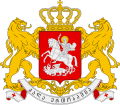
|

|
Tbilisi | Unitary parliamentary republic |
April 9, 1991 | 69,700 | 26,911 | 3,728,573 | 70.1% | 53 | 137 | [15][38] | |||
| Total South Caucasus | 186,043 | 71,832 | 16,831,069 | 82.0% | 89.3 | 231 | |||||||||
| Total former Soviet Union | 22,307,815 | 8,613,096 | 296,582,638 | 50.6% | 9 | 23 | [39] | ||||||||
Current leaders
Heads of state
Heads of government
Politics
Regarding political freedom in the former Soviet republics, Freedom House's 2021 report listed the following:
- Estonia, Latvia, and Lithuania as "free" countries.
- Armenia, Georgia, Moldova, and Ukraine were listed as "partly free".
- Azerbaijan, Belarus, Kazakhstan, Kyrgyzstan, Russia, Tajikistan, Turkmenistan, and Uzbekistan were listed as "not free".
Similarly, the Press Freedom Index published by Reporters Without Borders in 2022 recorded the following for press freedom:[41]
- Estonia — "Good situation"
- Latvia, Lithuania, Moldova — "Satisfactory situation"
- Armenia, Georgia, Kyrgyzstan, Ukraine — "Problematic situation"
- Kazakhstan, Tajikistan, Uzbekistan — "Difficult situation"
- Azerbaijan, Belarus, Russia, Turkmenistan — "Very serious situation"
It has been said that several post-Soviet states did not change leadership for decades since their independence, such as Nursultan Nazarbayev in Kazakhstan until his surprise resignation in 2019,[42] and Islam Karimov in Uzbekistan, until his death in September 2016.[43] All of these had originally more limited terms but through decrees or referendums prolonged their stay in office (a practice also followed by Presidents Alexander Lukashenko of Belarus and Emomali Rahmon of Tajikistan). Askar Akayev of Kyrgyzstan had served as President since its independence until he was forced to resign as a result of the Kyrgyz revolution of 2005.[44] Saparmurat Niyazov in Turkmenistan ruled from independence until his death in 2006, creating a personality cult around himself.[45] His successor, Gurbanguly Berdimuhamedow, has kept a personality cult of his own that has replaced the worshipping of Niyazov.[46]
The issue of dynastical succession has been another thing affecting the politics of some post-Soviet States. Heydar Aliyev, after creating an extensive and ongoing cult of personality, handed the Presidency of Azerbaijan to his son, Ilham Aliyev. Theories about the children of other leaders in Central Asia being groomed for succession abound.[47] The participation of Akayev's son and daughter in the 2005 Kyrgyz parliamentary elections boosted fears of dynastic succession being used in Kyrgyzstan as well, and may have contributed to the anti-Akayev climate that led to his overthrow.
Separatist conflicts
Economic, political, national, military, and social problems have all been reasons of separatism in the post-Soviet era. In many cases, problems because of reasons such as ethnic divisions existed before the fall of the Soviet Union, and upon the fall of the union were brought into the open.[48] Such territories and resulting military conflicts have so far been:
Current self-declared states
| Region | Country name | Coat of arms
|
Flag | Capital | Independence | Recognition | Area[10] | Population | Density | |||
|---|---|---|---|---|---|---|---|---|---|---|---|---|
| km2 | mi2 | p/km2 | p/mi2 | |||||||||
| Eastern Europe | Transnistria (Transnistrian Moldavian Republic) |

|
Tiraspol | 25 August 1991 (from |
Not recognised | 4,163 | 1,607 | 306,000 | 73.5 | 190.4 | ||
| Donetsk (Donetsk People's Republic) |

|
Template:Country data Donetsk People's Republic | Donetsk | 12 May 2014 (from |
Limited | 7,853 | 3,032 | 2,302,444 | 293.19 | 759.4 | ||
| Luhansk (Luhansk People's Republic) |

|

|
Luhansk | 12 May 2014 (from |
8,377 | 3,234 | 1,464,039 | 174.77 | 452.7 | |||
| South Caucasus | Artsakh (Republic of Artsakh) |

|
Stepanakert | 10 December 1991 (from |
Not recognised | 11,458 | 4,424 | 150,932 | 13.17 | 34.1 | ||
| South Ossetia (Republic of South Ossetia – the State of Alania) |

|
Tskhinval | 21 December 1991 (from |
Limited | 3,900 | 1,506 | 53,532 | 13.73 | 35.6 | |||
| Abkhazia (Republic of Abkhazia) |
Sukhumi | 23 July 1992 (from |
8,660 | 3,344 | 254,246 | 29.36 | 76.0 | |||||
 Transnistria, which is de facto independent from Moldova. It declared independence in 1990, because of its majority Russian-speaking population fearing union with Romania. A ceasefire between Transnistrian forces and Moldovan forces has been in place since 1992.
Transnistria, which is de facto independent from Moldova. It declared independence in 1990, because of its majority Russian-speaking population fearing union with Romania. A ceasefire between Transnistrian forces and Moldovan forces has been in place since 1992.- Template:Country data Donetsk People's Republic and
 Luhansk People's Republic, states which declared independence from Ukraine in 2014 and were recognized by Russia on 22 February 2022. They were formally annexed by Russia on 30 September 2022.
Luhansk People's Republic, states which declared independence from Ukraine in 2014 and were recognized by Russia on 22 February 2022. They were formally annexed by Russia on 30 September 2022.  Republic of Artsakh, which is de facto independent from Azerbaijan. Ethnic conflict between Armenians and Azerbaijanis began in 1988, and expanded into a war which lasted until a ceasefire in 1994. Attempts at negotiating a final peace and many bursts of violence have continued since then.[49]
Republic of Artsakh, which is de facto independent from Azerbaijan. Ethnic conflict between Armenians and Azerbaijanis began in 1988, and expanded into a war which lasted until a ceasefire in 1994. Attempts at negotiating a final peace and many bursts of violence have continued since then.[49] South Ossetia, which is de facto independent from Georgia. The region stated its goal to seek independence in 1990, leading to a conflict which led to a ceasefire in 1992. Separatism became powerful after the election of Georgian President Mikhail Saakashvili in 2004, and a referendum in 2006 was in favour of declaring independence. The 2008 war between Georgian forces and the separatist and Russian forces led to Russia's recognition of South Ossetia's independence.[50]
South Ossetia, which is de facto independent from Georgia. The region stated its goal to seek independence in 1990, leading to a conflict which led to a ceasefire in 1992. Separatism became powerful after the election of Georgian President Mikhail Saakashvili in 2004, and a referendum in 2006 was in favour of declaring independence. The 2008 war between Georgian forces and the separatist and Russian forces led to Russia's recognition of South Ossetia's independence.[50] Abkhazia, which is de facto independent from Georgia. Tensions in the area broke out when Georgia sent in troops in 1992 to control groups who wanted separation. The troops and most of the Georgian and Mingrelian speaking population were forced out in 1993, and the region declared independence in 1999. The 2008 war between Georgian forces and the separatist and Russian forces led to Russia's recognition of Abkhazia's independence.[51]
Abkhazia, which is de facto independent from Georgia. Tensions in the area broke out when Georgia sent in troops in 1992 to control groups who wanted separation. The troops and most of the Georgian and Mingrelian speaking population were forced out in 1993, and the region declared independence in 1999. The 2008 war between Georgian forces and the separatist and Russian forces led to Russia's recognition of Abkhazia's independence.[51]
Former self-declared states
| Region | Country name | Coat of arms
|
Flag | Capital | Independence | Fate | Area[10] | Population | Density | |||
|---|---|---|---|---|---|---|---|---|---|---|---|---|
| km2 | mi2 | p/km2 | p/mi2 | |||||||||
| Eastern Europe | Gagauzia (Gagauz Republic) |

|
Comrat | 19 August 1990 (from |
Reincorporated into Moldova as an autonomy in 1994 |
1,848 | 714 | 134,132 | 72.58 | 188.0 | ||
| Crimea (Republic of Crimea) |

|
Simferopol | 17 March 2014 (from |
Joined Russia after a referendum on the next day |
26,100 | 10,077 | 1,913,731 | 73.32 | 189.9 | |||
| Central Asia | Tatarstan (Republic of Tatarstan) |

|
Kazan | 21 March 1992 (from |
Reincorporated into Russia after peaceful negotiations in 1994 |
68,000 | 26,255 | 3,786,488 | 55.68 | 144.2 | ||
| South Caucasus | Chechnya (Chechen Republic of Ichkeria) |

|
Grozny | 8 June 1991 (from |
Disestablished in 2000 after the Second Chechen War |
15,300 | 5,907 | 1,103,686 | 72.14 | 186.8 | ||
| Talysh-Mughan (Толъш-Мъғонә Мохтарә Республикә) |

|

|
Lankaran | June 1993 (from |
Reincorporated into Azerbaijan in August 1993 | 7,465 | 2,882 | 960,000 | 128.6 | 333.1 | ||
 Gagauz Republic, declared itself the "Gagauz Autonomous Soviet Socialist Republic" within Moldova on 12 November 1989, and the "Gagauz Soviet Socialist Republic", independent of Moldova but still within the Soviet Union, on 19 August 1990, but was reintegrated into Moldova as an autonomous region on 23 December 1994.[52][53][54]
Gagauz Republic, declared itself the "Gagauz Autonomous Soviet Socialist Republic" within Moldova on 12 November 1989, and the "Gagauz Soviet Socialist Republic", independent of Moldova but still within the Soviet Union, on 19 August 1990, but was reintegrated into Moldova as an autonomous region on 23 December 1994.[52][53][54] Tatarstan, declared itself to be a sovereign state after a referendum on 21 March 1992. Negotiations with Russia led to the signing of a treaty in 1994 which ended Tatarstan's de facto independence, but reserved significant autonomy for the Tatarstan government. In 2002 a new constitution was enacted for Tatarstan which removed the prior constitution's declaration that Tatarstan was a sovereign state.
Tatarstan, declared itself to be a sovereign state after a referendum on 21 March 1992. Negotiations with Russia led to the signing of a treaty in 1994 which ended Tatarstan's de facto independence, but reserved significant autonomy for the Tatarstan government. In 2002 a new constitution was enacted for Tatarstan which removed the prior constitution's declaration that Tatarstan was a sovereign state. Republic of Crimea. The entire Crimean Peninsula has been outside the control of Ukrainian authorities since late February 2014, when Russian special forces and pro-Russian militias occupied the region.[55][56][57][58][59] In March 2014, a popular referendum in favor of accession to Russia was held in Crimea and Sevastopol, although Ukraine[60] and most of the international community refused to recognize the vote. The next day, the Republic of Crimea declared independence, and within days Russia absorbed the peninsula. Ukraine continues to claim Crimea as an integral part of its territory.
Republic of Crimea. The entire Crimean Peninsula has been outside the control of Ukrainian authorities since late February 2014, when Russian special forces and pro-Russian militias occupied the region.[55][56][57][58][59] In March 2014, a popular referendum in favor of accession to Russia was held in Crimea and Sevastopol, although Ukraine[60] and most of the international community refused to recognize the vote. The next day, the Republic of Crimea declared independence, and within days Russia absorbed the peninsula. Ukraine continues to claim Crimea as an integral part of its territory.- Chechen Republic of Ichkeria, where Dzhokhar Dudayev declared independence from Russia in 1991, leading to a violent war between local separatist forces and the Russian army. Russia first invaded in 1994, withdrawing after a deal for increased autonomy was granted in 1996. Tensions have continued in the years since then, and the conflict has spilled over into neighbouring regions such as Dagestan, Ingushetia and North Ossetia–Alania. Russia claims that the situation in Chechnya has normalised.[61]
 Talysh-Mughan, declared independence from Azerbaijan, that lasted from June to August 1993.[62]
Talysh-Mughan, declared independence from Azerbaijan, that lasted from June to August 1993.[62]
Civil wars
Civil wars unrelated to separatist movements have occurred twice in the region:
- The Georgian Civil War between the forces of Zviad Gamsakhurdia and Eduard Shevardnadze. The war ended after Russian forces intervened in support of Shevardnadze's government, which in turn agreed to join the Commonwealth of Independent States.
- The Tajikistani Civil War that lasted between 1992 and 1997.
Colour revolutions
Since 2003, a number of (largely) peaceful "colour revolutions" have happened in some post-Soviet states after disputed elections, with popular protests bringing into power the former opposition.
- The Rose Revolution in Georgia, leading to the resignation of Eduard Shevardnadze.
- The Orange Revolution in Ukraine, bringing into power Viktor Yushchenko and toppling the pro-Russian leader Viktor Yanukovych.
- The Tulip Revolution in Kyrgyzstan, leading to the resignation of Askar Akayev.
- The Velvet Revolution in Armenia, leading to the resignation of Serzh Sargsyan.
Related articles
Post-Soviet States Media
References
- ↑ "Managing Conflict in the Former Soviet Union: Russian and American Perspectives". harvard.edu. 30 October 1997. Archived from the original on 3 March 2016. Retrieved 2 December 2015.
- ↑ "Про правонаступництво України". Zakon.rada.gov.ua. Retrieved 21 February 2022.
- ↑ "Раздел СССР. РФ обсудит нулевой вариант долгов СССР, если Украина компенсирует $20 млрд долга". Korrespondent.net.
- ↑ Van Elsuwege, Peter (2008). From Soviet Republics to Eu Member States: A Legal and Political Assessment of the Baltic States' Accession to the EU. Studies in EU External Relations. Vol. 1. BRILL. p. xxii. ISBN 9789004169456.
- ↑ Smith, David James (2001). Estonia. Routledge. p. 20. ISBN 978-0-415-26728-1.
- ↑ Lane, David (December 2007). "Post-Communist States and the European Union". Journal of Communist Studies and Transition Politics. 23 (4): 461–477. doi:10.1080/13523270701674558. ISSN 1352-3279.
- ↑ Moga, Teodor Lucian; Alexeev, Denis (2013). "Post-Soviet States Between Russia and the EU: Reviving Geopolitical Competition? A Dual Perspective" (PDF). Connections. 13 (1): 41–52. doi:10.11610/Connections.13.1.03. JSTOR 26326349 – via JSTOR.
- ↑ Jozwiak, Rikard (2019-04-05) (in en). EU, Ex-Soviet Republics To Extend Partnership Beyond 2020. Radio Free Europe/Radio Liberty. https://www.rferl.org/a/eu-ex-soviet-republics-to-extend-partnership-beyond-2020/29863540.html. Retrieved 2021-08-10.
- ↑ Danilova, Maria; Dahlburg, John-Thor (2014-03-17) (in en-US). Crimea declares independence. https://www.bostonglobe.com/news/world/2014/03/17/russia-calls-ukraine-federal-state/X3ipImb0DIelYk4PsRfmNP/story.html. Retrieved 2021-08-10.
- ↑ 10.0 10.1 10.2 Area includes land and water.
- ↑ Population data as of February 1, 2014.
- ↑ "The Agency of Statistics of the Republic of Kazakhstan : Latest data". Archived from the original on 1 August 2013. Retrieved 5 March 2022.
- ↑ Population data as of 2015.
- ↑ "Official estimate". Stat.kg. Retrieved 5 March 2022.
- ↑ 15.0 15.1 15.2 15.3 15.4 Population data as of January 1, 2014.
- ↑ "Statistical Agency under President of the Republic of Tajikistan". March 6, 2012. Archived from the original on 2012-03-06.
- ↑ Population data as of July 1, 2013.
- ↑ UN estimate
- ↑ "Государственный комитет Республики Узбекистан по статистике - Демографические данные". Archived from the original on 23 July 2014.
- ↑ Population data as of July 1, 2014.
- ↑ "Demographic situation in Half-Year 2014". July 29, 2014. Archived from the original on 2014-07-29.
- ↑ Population data as of January 1, 2017.
- ↑ Statistică, Biroul Naţional de. "// Populaţia și procesele demografice". statistica.gov.md.
- ↑ The Russian Federation technically achieved de facto independence from the Soviet Union after ratifying the Belavezha Accords. After the Almaty Protocol, the RF took over the Soviet Union's UN membership.
- ↑ Population data as of January 1, 2018.
- ↑ "Official estimate". Gks.ru. Archived from the original (XLS) on 17 March 2018. Retrieved 5 March 2022.
- ↑ Includes the Republic of Crimea and Sevastopol, claimed by Ukraine.
- ↑ Population data as of April 1, 2014.
- ↑ "Population as of April 1, 2014. Average annual populations January-March 2014". Ukrstat.gov.ua.
- ↑ Population data as of January 1, 2015.
- ↑ "Official estimate". Stat.ee. Archived from the original on 23 November 2012. Retrieved 5 March 2022.
- ↑ "Population - Key Indicators | Latvijas statistika". June 28, 2013. Archived from the original on 2013-06-28.
- ↑ "Number of persons by month - Database of Indicators - data and statistics". August 19, 2010. Archived from the original on 2010-08-19.
- ↑ Population data as of 2012.
- ↑ "Feedback / Statistical Committee of the Republic of Armenia". Armstat.am. Retrieved 5 March 2022.
- ↑ Population data as of December 31, 2013.
- ↑ Samadov, Anar. "2013-cü ildə ölkənin iqtisadi və sosial inkişafının makroiqtisadi göstəriciləri". Stat.gov.az. Retrieved 5 March 2022.
- ↑ "საქართველოს სტატისტიკის ეროვნული სამსახური". Geostat.ge.
- ↑ Frank Lorimer. "The Population of the Soviet Union : History and Prospects" (PDF). Marxists.org. Retrieved 5 March 2022.
- ↑ 40.0 40.1 Holds both presidency and executive powers as the Prime Minister of Turkmenistan role was abolished.
- ↑ "2020 World Press Freedom Index | Reporters Without Borders". Rsf.org. Retrieved 2021-06-12.
- ↑ "Managed leadership succession in Kazakhstan: A model for gradual departure?". Fiia.fi (in suomi). 2020-03-16. Retrieved 2021-08-10.
- ↑ Higgins, Andrew (2018-04-02) (in en-US). As Authoritarianism Spreads, Uzbekistan Goes the Other Way. . https://www.nytimes.com/2018/04/01/world/asia/uzbekistan-reform.html. Retrieved 2021-08-10.
- ↑ "Kyrgyzstan: between democratisation and authoritarianism". Gis-reseau-asie.org. Archived from the original on 2021-08-10. Retrieved 2021-08-10.
- ↑ agencies, Staff and (2006-12-21). "The personality cult of Turkmenbashi". The Guardian. Retrieved 2021-08-10.
- ↑ Sattarov, Rafael. "Turkmen Leader's Personality Cult Goes Viral". Carnegie.ru. Retrieved 2021-08-10.
- ↑ "Kazakhstan flirts with dynastic succession Dariga Nazarbayeva has led a charmed life. / Kazakhstan's Democratic Forces Forum". Archived from the original on 2005-03-12. Retrieved 2005-04-05.
- ↑ "National Construction, Territorial Separatism and Post-Soviet Geopolitics: The Example of the Transdniester Moldovan Republic" (PDF). Colorado.edu. Retrieved 21 February 2022.
- ↑ "Regions and territories: Nagorno-Karabakh". BBC News. 10 January 2012. http://news.bbc.co.uk/2/hi/europe/country_profiles/3658938.stm.
- ↑ "Regions and territories: South Ossetia". BBC News. 25 April 2012. http://news.bbc.co.uk/2/hi/europe/country_profiles/3797729.stm.
- ↑ "Regions and territories: Abkhazia". BBC News. 12 March 2012. http://news.bbc.co.uk/2/hi/europe/3261059.stm.
- ↑ Chinn, Jeff; Roper, Steven (1998). "Territorial autonomy in Gagauzia". Nationalities Papers. 26 (1): 87–101. doi:10.1080/00905999808408552. S2CID 154359743.
But on 19 August 1990, the Gagauz elite, led by President Stepan Topal and Supreme Soviet Chairperson Mihail Kendighelean, quickly took the next step, declaring Gagauzia to be independent of Moldova and subject only to central Soviet authority
- ↑ Neukirch, Claus. "Autonomy And Conflict Transformation: The Case Of The Gagauz Territorial Autonomy In The Republic Of Moldova" (PDF). European Centre for Minority Issues. Archived from the original (PDF) on 2014-10-14. Retrieved 2014-10-09.
On 12 November 1989, a "Gagauz Autonomous Soviet Socialist Republic" was proclaimed by an assembly in Comrat ... In reaction to the Moldovan declaration of sovereignty, on 19 August 1990 the Gagauz leadership proclaimed a "Gagauz Soviet Socialist Republic", which would be independent from Moldova, but part of the Soviet Union ... on 23 December 1994 the Moldovan Parliament passed the "Law on the Special Juridical Status of Gagauzia (Gagauz-Yeri)"
{{cite journal}}: Cite journal requires|journal=(help) - ↑ Zabarah, Dareg (2012). "Opportunity structures and group building processes: An institutional analysis of the secession processes in Pridnestrovie and Gagauzia between 1989 and 1991". Soviet and Communist Studies. 45 (1–2).
According to the first point of its declaration, the Gagauz Republic "is a sovereign, socialist, soviet and multinational state
- ↑ Herszenhorn, David; Kramer, Andrew (19 March 2014). Ukraine Plans to Withdraw Troops From Russia-Occupied Crimea. https://www.nytimes.com/2014/03/20/world/europe/crimea.html. Retrieved 6 August 2014.
- ↑ Kristina Zakurdaeva; Mikhail Maglov (3 December 2019). The Crimea Circumvention: How EU Firms Are Sidestepping Sanctions And Making Money On The Peninsula. Current Time TV. https://www.rferl.org/a/crimea-how-eu-firms-sidestepping-sanctions-making-money-on-peninsula/30303687.html. Retrieved 15 November 2020.
- ↑ Carl Schreck (26 February 2019). From 'Not Us' To 'Why Hide It?': How Russia Denied Its Crimea Invasion, Then Admitted It. Radio Free Europe/Radio Liberty. https://www.rferl.org/a/from-not-us-to-why-hide-it-how-russia-denied-its-crimea-invasion-then-admitted-it/29791806.html. Retrieved 15 November 2020.
- ↑ "Vladimir Putin in TV denial that Russian special forces are in eastern Ukraine". The Daily Telegraph. 17 April 2014. Archived from the original on April 17, 2014. Retrieved 13 August 2014.
- ↑ "Russian Special Forces Storm Crimea Base". Sky News. 23 March 2014. Retrieved 13 August 2014.
- ↑ Ukraine PM rejects Crimea referendum, vows to defend country. CBC News. 6 March 2014. http://www.cbc.ca/news/world/ukraine-pm-rejects-crimea-referendum-vows-to-defend-country-1.2561973. Retrieved 6 August 2014.
- ↑ "Regions and territories: Chechnya". BBC News. 22 November 2011. http://news.bbc.co.uk/2/hi/europe/country_profiles/2565049.stm.
- ↑ "Azerbaijan in a stir over political prisoner". News.bbc.co.uk. 6 February 2003. Retrieved 21 February 2022.

